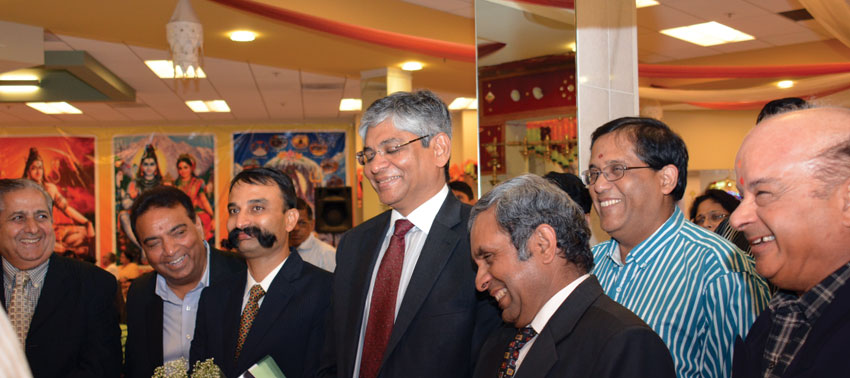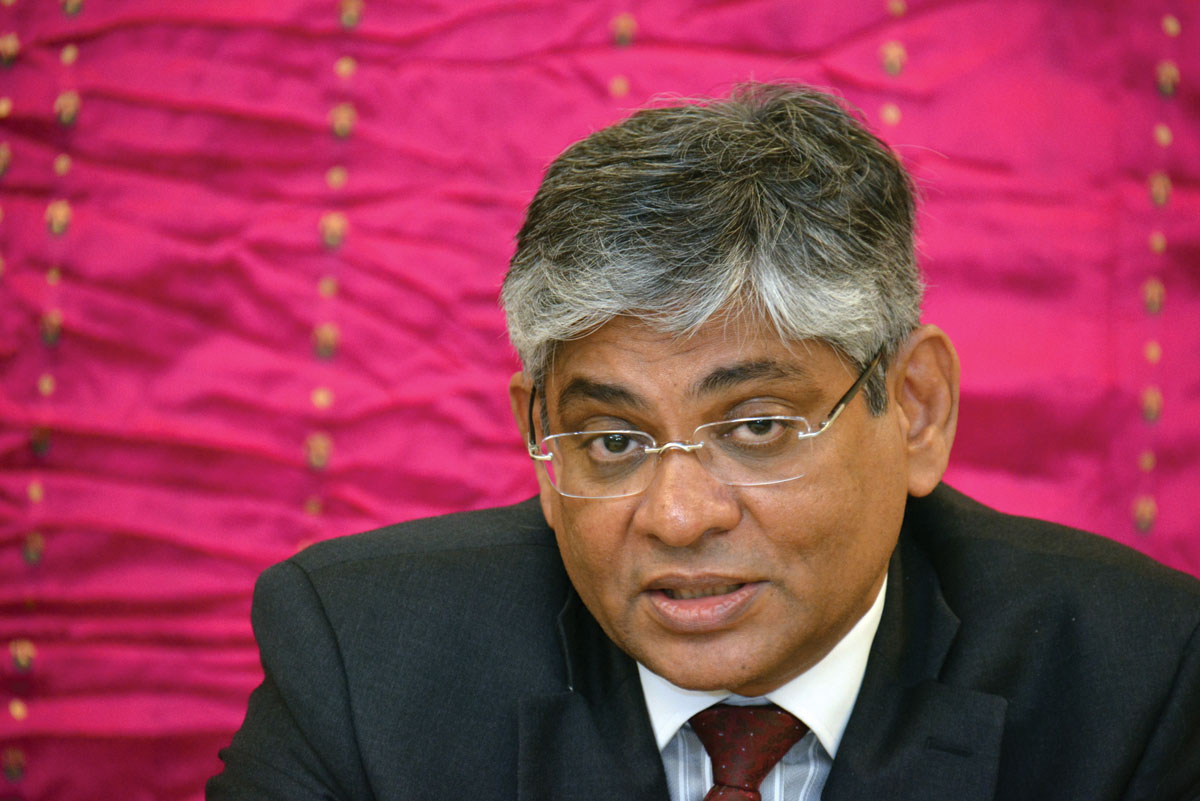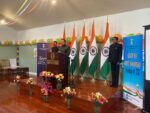NATURAL ALLIES
India’s Ambassador to U.S. Arun K. Singh talks to Silicon Valley’s Indian media at Sunnyvale Hindu Temple, July 24. (Amar D. Gupta | Siliconeer)
After assuming charge as India’s Ambassador to U.S. about three months ago, Ambassador Arun Kumar Singh, visited San Francisco Bay Area last month. During the visit, he met with local Indian media at Sunnyvale Hindu Temple, July 24, where he spoke on Indo-U.S. relations. A Siliconeer report.
Speaking at a meet and greet event for the media, Ambassador Singh stated that he looked forward to enhance the opportunities for engagement between India and the United States in the economic sector as well as in other areas.
Describing the present day Indo-U.S. relationship as “very strong,” he cited the visit of Prime Minister Modi to the U.S. in September 2014 and President Obama’s visit to India in January this year as the outcome of the same.
This is the first time that a U.S. President has visited India twice in his tenure and the first time that an U.S. President has gone to India on Republic Day. He described this as a clear reflection of progress of the current day relationship between the two countries. Ambassador Singh referred to President Obama’s statement that “the Indo-U.S. relationship can be one of the defining partnerships of this century,” and Prime Minister Modi’s statement that “India and the U.S. are natural allies.”

Ambassador Singh added that both countries share common ideals: democracy, pluralism and rule of law, and there is a huge opportunity in different areas of cooperation including in the economic sector.
Ambassador Singh also said that the current level of the trade between the two countries is $100 billion and added that the leaders of both nations have sought to increase it to $500 billion. He stated that during the last five years, Indian companies have invested more than $15 billion in the U.S., creating about a 100,000 jobs in the U.S. directly and several more, indirectly.
Conveying that U.S. companies have been present in India for a long time, the Ambassador emphasized that there are great economic opportunities in India like, “Make in India,” “Digital India” and other schemes, in addition to opportunities in infrastructure, renewable energies, and education.
Appreciating the West Coast of the U.S. for its focus on innovation and entrepreneurship, the Ambassador informed that a lot of work on innovation and entrepreneurship is taking place in India at present. He said that the startup sector in India is growing and as per estimates, almost $4 billion has been invested into startups in India, in the last two years. Highlighting India’s recent Mission to Mars, Ambassador Singh stated that India is the 4th country in the world to send a vehicle to Mars and the first country to succeed in its first attempt. He added that the cost for this Mission was only $ 65 million, which is less than the cost of production of a Hollywood film focusing on space and it highlights the cost effective innovation and research happening in India.
Ambassador Singh said that the most important fact that provides firm basis to the Indo-U.S. relationship is “people to people interaction.” There are more than 3 million Indian-Americans in the U.S. and with about 110,000 Indian American doctors, one in every seven patients in the U.S. is being treated by an Indian American doctor. Also about 100,000 Indian students are pursuing studies in various U.S. universities and approximately 40% of the hotels in the U.S. are owned or managed by Indians. The situation reveals that there is a huge engagement at people to people level with the U.S. and it is on this basis that India wants to take forward the relationship with the U.S.
The Ambassador answered several questions from media.
Q: Though the Indo-U.S. nuclear deal was signed in 2005, why has nothing happened as a decade goes by. Is the U.S. creating barriers for the same?
A: There has been progress as far as the Indo-U.S. nuclear deal is concerned. The announcement of the deal was made in 2005 and the agreement was signed in 2008. During the visit of President Obama in January this year, the pending issues were resolved, and now two companies in the U.S. that have the capacity in this area are discussing the commercial and technical aspects with Indian operators.
Q: Entrepreneurs are still facing difficulties in starting a company in India. What about the Indian government’s efforts to create a “single window clearance facility” to obtain all the necessary clearances?
A: Since May last year, a whole series of new measures have been brought in and the permissions required have been reduced and most of the things one needs to do can be done online. There is ease and much more transparency in the process. Secondly, an Inter-ministerial group has been setup to address the problems U.S. investors might be facing. The Inter-ministerial group is located in the office of the Secretary, Department of Industrial Policy and Promotion. It is the organizing body and the secretariat for the group. In addition, there is another organization called ‘Invest India’ (the details of which are available on the web). It is a public private partnership with the Government of India and apex industrial organizations like FICCI etc. and they have now been revitalized to help investors.
Q: What is the level of Indo-U.S. defense cooperation and joint military exercises?
A: The defense cooperation with U.S. is strong and during the last four years, India has bought about $10 billion worth of defense supplies from the U.S., which is more than from any other country. It is the reflection of our relationship but what is new is that the two governments have announced to move away from the buyer-seller relationship with co-development and co-production. We have identified six pathfinder projects for co-development and once that is in progress that will further deepen defense cooperation. As far as the joint military exercises of India and U.S., it has been said that the largest number of military exercises both India and U.S. had with any country in the world, is with each other.
Q: According to a recent news release, Prime Minister Modi is scheduled to visit the San Francisco Bay Area in September this year. Can you please elaborate on his plans?
A: Planning is still being done in this direction and whenever details are available with us to share, the same will be shared.
(Read “Welcoming PM Modi to SF Bay Area: Silicon Valley plans MSG-like Reception” story on Siliconeer at http://siliconeer.com/current/welcoming-pm-modi-to-sf-bay-area/)


